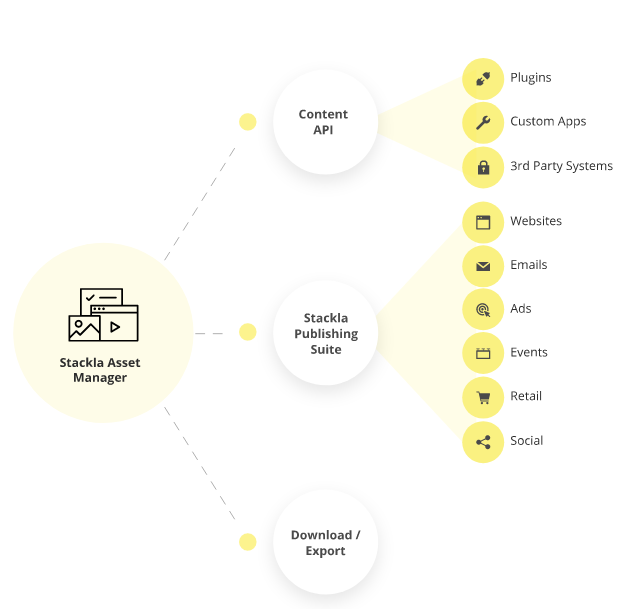Stackla DAM Enables First AI-Powered Content Discovery
“You can use social media to turn strangers into friends, friends into customers and customers into salespeople.” - Seth Godin, Author, Entrepreneur, and Marketer.
into salespeople.” - Seth Godin, Author, Entrepreneur, and Marketer.
According to recent research that surveyed 2,000 adults in the U.S., U.K., and Australia, up to 86 percent of customers see authenticity as a critical factor when making a purchase, and people find consumer-created content to be the most authentic form of content. Consumers are three times more likely to say that content created by a consumer is authentic compared to content created by a brand.
While consumers’ high desire for user-generated content (UGC) drives brands to adopt technologies that help them identify authentic customer content across digital channels, technology providers have been innovating and/or integrating with the cutting-edge UGC capabilities. A case in point, Stackla, the visual content engine for brands, announced the Stackla Asset Manager (SAM), “the first digital asset manager (DAM)” that allows marketers to not only store, organize and distribute all their visual assets but also actively discover new visual content from across the social web. Stackla Asset Manager’s cloud infrastructure is powered by Amazon.
“The plight of today’s marketer is no longer how to reach consumers, but rather how to produce the volume and quality of content needed to satisfy content-hungry audiences,” said Damien Mahoney, CEO, and Co-Founder of Stackla. “With the Stackla Asset Manager, we’re going beyond the standard storage, cataloging and distribution of a typical DAM to put the power of real-time content discovery and recommendation in the hands of marketers who constantly struggle to create, access, deliver and reuse visual assets efficiently.”
Overview of Stackla
To detect the best user-generated content from 25+ sources on the social web and beyond, Stackla utilizes its own custom web-crawling search engine that scours social channels like Twitter, Facebook, Instagram, and YouTube for a collection of hashtags or keywords. It can also search through content put up by specific influencers or by some specific geography.
Users can integrate Stackla with their other enterprise technologies and access all their data via a comprehensive suite of APIs and developer tools such as REST and JavaScript APIs, Webhooks, SDKs, and Enterprise plugins.

Here are some other significant features of the new Stackla Asset Manager:
-
Content Discovery - As the only DAM enabling constant content discovery, the Stackla Asset Manager helps marketers actively build a rich library of compelling, authentic assets to augment the content created by their brand teams and agencies.
-
Content Organization & Recommendation - Centralizing all of brands’ earned, paid and owned assets into a single, dynamic platform, the SAM uses AI technology and visual recognition to auto-tag and enrich assets with relevant metadata while making predictive content recommendations and enabling custom taxonomies for quick and easy search and filtering.
-
Multi-Channel Content Distribution - Marketers can activate their visual content across any distribution channel – creating engaging and personalized content experiences on websites, emails, advertisements, eCommerce, social channels and more with the click of a button.
-
Platform Reliability - Brands can enjoy secure, fast, around-the-clock access to the SAM’s cloud-based platform, with enterprise-grade user access controls, single sign-on (SSO) and multi-factor authentication (MFA) to ensure assets are stored securely and delivered efficiently to target audiences.
Sitecore and Stackla Partner to Deliver User-Generated Content
Last month, Sitecore and Stackla announced an expanded partnership that integrates Stackla into the Sitecore Experience Cloud platform. The integration is expected to enable Sitecore customers to dynamically display UGC across their digital marketing campaigns. "Together, Sitecore and Stackla realize the power of personalization with real customers telling a brand's story through their own experiences in real time," said Mark Frost, Chief Executive Officer at Sitecore.
Data insights and content performance patterns tracked by Stackla are captured directly in the Sitecore Experience Database™ (xDB) database, providing marketers with a holistic view of their customers, according to Sitecore. This partnership perfectly serves Sitecore’s focus in its most recent version (Sitecore Experience Cloud 9) as it seems to be on the data-driven contextual marketing side of things. Speaking to CMS-Connected, the Sitecore team said: “The value behind Sitecore xDB and Sitecore xConnect is not just collecting customer data, but connecting it from every customer interaction—both online and offline—and making it available to marketers (and sales, customer service agents, and other internal users), in real-time and at scale, for automated interactions across all channels that shape the customer experience.”
Here are the key features of the Stackla for Sitecore UGC Connector:
-
Create Stackla UGC display widgets and embed social content directly within web pages using Sitecore admin tools
-
Personalize Stackla-curated content that is pushed to each user from Sitecore’s web content management, digital marketing, and e-commerce solutions
-
Use Stackla to discover what users are posting on social media about your brand and feed the information back into Sitecore.
Stackla for Good
Stackla’s platform has been adopted across various industries, including travel, hospitality, CPG, retail, sports, and nonprofits. The vendor works with more than 450 brands that involve many enterprise-level organizations; Disney, McDonald’s, Toyota, Sony, Expedia, Heineken and Virgin Holidays to name a few.
Lately, Stackla has become very popular among not only commercial enterprises but also large non-profit organizations. Since its launch in 2012, the technology provider has worked with more than 30 nonprofits, including Greenpeace, No Kid Hungry, and the ACLU. The company accommodated in an ad hoc way by offering various kinds of discounts based on the size and scope of the work. To satiate the emerging interest from nonprofits, last August, Stackla rolled out a new division called Stackla for Good.
It is no secret anymore that many decision-makers put a lot of emphasis on other people’s opinions when making decisions. In fact, 92% of people trust peer recommendations more than any form of marketing. You may wonder why nonprofits have a somewhat distrusting audience as they have a strong core mission, rather than selling something but, given we have lately been exposed to so many news reporting on corruptions with large, respected nonprofit organizations, people don’t generally trust charitable organizations to handle their money wisely. With this in mind, Stackla is trying to help nonprofits incorporate UGC throughout their digital marketing mix to attract, support and drive donations by spreading out their message about their cause and gaining endorsement for their mission.
“The way that we think about user-generated content is that it’s the most authentic and realistic sort of content that marketers can tap into and push out to their customers,” says CEO and co-founder Damien Mahoney. “It is highly trusted, it resonates with other customers, and it drives engagement. For [nonprofits], that’s really enhanced by people who are passionate about the cause.”
The tight budget and the lack of staff possess the biggest challenge for nonprofits. Therefore, harnessing the power of UGC brings a great advantage to especially, cash-strapped nonprofits as they can deliver better and more authentic content with less effort and budget. To help nonprofits with this task, Stackla offers not only a dedicated division (Stackla for Good) but also a small incentive by annually awarding the most innovative UGC driven campaign.
User-generated content is only one of the content marketing tactics that nonprofits can immediately take advantage of to acquire new donors, engage with the community, increase awareness, donor retention, and scaling. To learn more about the other tactics, here’s a content marketing strategy guide for nonprofit marketers.
Authenticity is King
The research by Stackla cited in my opening paragraph is jam-packed with so much data goodness that it is hard to boil it down into a few top takeaways. However, I would like to share a couple of them that stand out the most from the report for me:

-
60% of consumers say content from a friend or family member influences their purchases decisions, while just 23% of consumers say content from celebrities influenced their purchasing decisions.
-
85% of people (and 97% of Millennials) say they would share a positive travel experience on social media
-
Nearly 52% of people say they post on social media at least once a month about products they've purchased.
-
30% of Millennials saying they have unfollowed a brand on social media because they felt their content was inauthentic.
For more statistics on the consumer perception about user-generated content, you can view the full report here.
My POV
UGC used to be seen as a marketing tactic that only works for B2C brands simply because their products/services have something “fun and exciting” to offer most of the time. However, in recent years, with many B2B brands cashing in on UGC and driving lucrative results from those efforts, the perception has begun to change.
As the stats above also indicated, some customers willingly share reviews because they are simply excited about their new purchases. However, an effective UGC strategy shouldn’t rely on the goodwill of customers alone. First, organizations should make their audiences feel inspired and motivated to take action. Second, they need to monitor them. With the ongoing explosion of content, channels, and devices, manually tracking down what people say about a brand is almost mission impossible. Fortunately, having technologies like Stackla at our disposal to help us manage user-generated content in a secure manner with granular access controls makes it possible.

Venus Tamturk
Venus is the Media Reporter for CMS-Connected, with one of her tasks to write thorough articles by creating the most up-to-date and engaging content using B2B digital marketing. She enjoys increasing brand equity and conversion through the strategic use of social media channels and integrated media marketing plans.